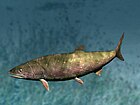Parasemionotiformes
| Parasemionotiformes Temporal range: | |
|---|---|

| |
| Albertonia cupidinia fossil | |
| Scientific classification | |
| Domain: | Eukaryota |
| Kingdom: | Animalia |
| Phylum: | Chordata |
| Class: | Actinopterygii |
| Infraclass: | Holostei |
| Order: | †Parasemionotiformes Lehman, 1966 |
| Families | |
| |
Parasemionotiformes is an extinct order of neopterygian ray-finned fish that existed globally during the Triassic period. It comprises the families Parasemionotidae and Promecosominidae. Many of the included genera are monotypic and most species lived during the Early Triassic epoch.[1][2]
Parasemionotiforms were normally small to medium-sized fishes. They were predominantly marine.[3]
Evolutionary relationships
Parasemionotiformes are neopterygians, which is the clade that encompasses the vast majority of living ray-finned fishes (Actinopterygii) and about half of all living species of vertebrates.[4] Neopterygii are divided into Teleostei and Holostei. The latter represents a depauperate group today but used to be a diverse clade especially during the Mesozoic Era. The only surviving members of the Holostei are the gars (Ginglymodi) and the bowfin (Halecomorphi).[4]
Parasemionotiformes belong to Holostei and are one of the earliest clades of the Halecomorphi (bowfin and its extinct relatives).[5] Parasemionotiformes are the sister group to all other halecomorphs according to cladistic analyses.[6]
The following tree summarizes the evolutionary relationships of the Parasemionotiformes. Names accompanied by a dagger (†) represent extinct groups.
| Neopterygii |
| ||||||||||||||||||||||||||||||
Classification





- Order †Parasemionotiformes Lehman, 1966[1]
- Family incertae sedis
- Genus †Peia Ji, 2009
- †Peia jurongensis Ji, 2009 (type species)
- Genus †Peia Ji, 2009
- Family †Parasemionotidae Stensiö, 1932 (= Ospiidae Stensiö, 1932)
- Genus †Parasemionotus Piveteau, 1929
- †Parasemionotus labordei (Priem, 1924) (type species)
- †Parasemionotus besairiei Lehman et al., 1959
- Genus †Ospia Stensiö, 1932
- †Ospia whitei Stensiö, 1932 (type species)
- Genus †Broughia Stensiö, 1932
- †Broughia perleididoides Stensiö, 1932 (type species)
- Genus †Watsonulus Brough, 1939 (= Watsonia Piveteau, 1934)
- †Watsonulus eugnathoides (Piveteau, 1934) (type species)
- Genus †Stensionotus Lehman, 1952
- †Stensionotus intercessus Lehman, 1952 (type species)
- †Stensionotus dongchangensis Liu et al., 2002
- Genus †Jacobulus Lehman, 1952
- †Jacobulus novus Lehman, 1952 (type species)
- Genus †Thomasinotus Lehman, 1952
- †Thomasinotus divisus Lehman, 1952 (type species)
- Genus †Albertonia Gardiner, 1966
- †Albertonia cupidinia (Lambe, 1916) (type species)
- Genus †Lehmanotus Beltan, 1968
- †Lehmanotus markubai Beltan, 1968 (type species)
- Genus †Devillersia Beltan, 1968
- †Devillersia madagascariensis Beltan, 1968 (type species)
- Genus †Piveteaunotus Beltan, 1968
- †Piveteaunotus ifasiensis Beltan, 1968 (type species)
- Genus †Icarealcyon Beltan, 1980
- †Icarealcyon malagasium Beltan, 1980 (type species)
- Genus †Jurongia Liu et al., 2002
- †Jurongia fusiformis Liu et al., 2002 (type species)
- Genus †Qingshania Liu et al., 2002
- †Qingshania cercida Liu et al., 2002 (type species)
- Genus †Suius Liu et al., 2002
- †Suius brevis Liu et al., 2002 (type species)
- Genus †Candelarialepis Romano et al., 2019
- †Candelarialepis argentus Romano et al., 2019 (type species)
- Genus †Parasemionotus Piveteau, 1929
- Family †Promecosominidae Wade, 1940
- Genus †Promecosomina Wade, 1935
- †Promecosomina formosa (Woodward, 1890) (type species) (= P. beaconensis Wade, 1935)
- Genus †Promecosomina Wade, 1935
- Family incertae sedis
See also
References
- ^ a b Romano, Carlo; Ware, David; Brühwiler, Thomas; Bucher, Hugo; Brinkmann, Winand (2016). "Marine Early Triassic Osteichthyes from Spiti, Indian Himalayas". Swiss Journal of Palaeontology. 135 (2): 275–294. Bibcode:2016SwJP..135..275R. doi:10.1007/s13358-015-0098-6.
- ^ Romano, Carlo; López-Arbarello, Adriana; Ware, David; Jenks, James F.; Brinkmann, Winand (April 2019). "Marine Early Triassic Actinopterygii from the Candelaria Hills (Esmeralda County, Nevada, USA)". Journal of Paleontology. 93 (5): 971–1000. Bibcode:2019JPal...93..971R. doi:10.1017/jpa.2019.18. S2CID 155564297.
- ^ Romano, Carlo; Koot, Martha B.; Kogan, Ilja; Brayard, Arnaud; Minikh, Alla V.; Brinkmann, Winand; Bucher, Hugo; Kriwet, Jürgen (February 2016). "Permian-Triassic Osteichthyes (bony fishes): diversity dynamics and body size evolution". Biological Reviews. 91 (1): 106–147. doi:10.1111/brv.12161. PMID 25431138. S2CID 5332637.
- ^ a b Nelson, Joseph, S. (2016). Fishes of the World. John Wiley & Sons, Inc. ISBN 978-1-118-34233-6.
{{cite book}}: CS1 maint: multiple names: authors list (link) - ^ Olsen, P.E. (1984). "The skull and pectoral girdle of the parasemionotid fish Watsonulus eugnathoides from the Early Triassic Sakamena Group of Madagascar, with comments on the relationships of the holostean fishes". Journal of Vertebrate Paleontology. 4 (3): 481–499. Bibcode:1984JVPal...4..481O. doi:10.1080/02724634.1984.10012024.
- ^ Sun, Zuoyu; Tintori, Andrea; Xu, Yaozhong; Lombardo, Cristina; Ni, Peigang; Jiang, Dayoung (April 2017). "A new non-parasemionotiform order of the Halecomorphi (Neopterygii, Actinopterygii) from the Middle Triassic of Tethys". Journal of Systematic Palaeontology. 15 (3): 223–240. Bibcode:2017JSPal..15..223Z. doi:10.1080/14772019.2016.1181679. S2CID 133176227.





